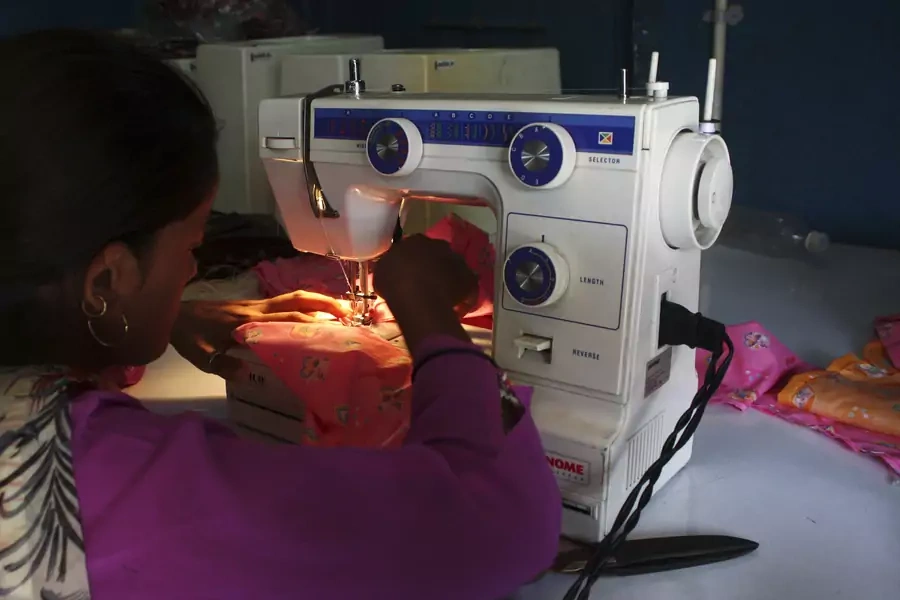Five Questions on Women-Led Sustainable Development: Meagan Fallone

The Five Questions Series is a forum for scholars, government officials, civil society leaders, and foreign policy practitioners to provide timely analysis of new developments related to the advancement of women and girls worldwide. This interview is with Meagan Fallone, the director of Barefoot College International. In this interview Fallone highlights how Barefoot’s Solar Mama’s initiative has empowered women and poor communities around the world.
Can you tell us about Barefoot College’s Solar Mamas initiative?
Barefoot College’s Solar Mamas initiative is the only one of its kind. We identify rural, poor, and non-electrified communities, establish communication with members and local partners, and secure their buy-in to participate in a sustainable solar electrification program that will improve their lives. The members then identify women from their community to be trained as solar engineers, or Solar Mamas.
More on:
These women travel to Tilonia, India, where they are trained as Solar Engineers using Barefoot’s literacy-optional sign language and color-coding learning system. This is because many of the women we train are illiterate or semi-literate. It is important for Solar Mamas to learn fast, and acquire ability to teach other members of their community who may also be illiterate. The communities also establish a committee to create and manage a common fund that is used to pay for the solar equipment and the Solar Mamas’ wages to assemble and maintain it. These payments are typically a proportion of what the community previously spent on fuels, such as kerosene.
How has Solar Mamas empowered individuals, females and communities?
The Solar Mamas program creates a huge change in the lives of poor rural women by elevating them to the status of industry experts. Many of these women are raised to believe that they are not worth the resources it would take to educate them. This mentality contributes to gender inequality and marginalizes half of the workforce in communities that are struggling to survive. Becoming a Solar Mama allows women to realize their potential. They become leaders and agents of change in their communities, and their communities experience firsthand the benefits of empowering women.
From your experiences with partnerships, how do you think the private sector can best support initiatives to empower women, reduce poverty, and support sustainable development?
For many companies in the private sector, working with initiatives that empower women, reduce poverty, and create sustainable development is a way to help create a healthier global economy. In my own experience, I have found that companies with a global reach need dependable and enthusiastic partners based in the areas they want to support. Hogan Lovells’ partnership with Barefoot is a great example of this.
You have said before that illiterate and semi-literate women from poor rural villages may be the ideal people to lead the next global technology surge. Can you explain why?
These women come at problems from a unique and practical perspective. Often, the problem with technological innovations is that they are expensive, inaccessible, and not fully in touch with what people need or want in their daily lives. However, these women interact with technology differently. They don’t have preconceptions about what technology should do – they look at what it actually does, and they see ways to improve it that are based on real life issues, and more importantly, based on making that technology accessible to everyone in their community. This makes them the ideal people to lead innovations as to how we use technology.
More on:
Earlier this month, the United Nations released a report warning that human actions have led to a dangerous decline in biodiversity. The report urged world leaders to step up efforts to address climate change, noting that, “through ‘transformative change' nature can still be conserved, restored, and used sustainably.” Does Barefoot College have a plan to expand its efforts to promote sustainability?
Transformative change is exactly what we do. When we look at a problem – in this case the problem of rural poverty – we try to identify the root cause and then make changes that will last. That means we have to address everything that contributes to rural poverty, which might sound like a wildly large amount of problems, but in reality is actually relatively simple, and also directly related to the question of sustainability.
Poor rural communities have three very simple problems. First, they are remote, and so they are cut off from power. Second, they are time-poor, because they are limited in work by daylight hours. Third, and most importantly, women are typically marginalized. This is a very serious problem, because it means half the workforce is discarded. For a sustainable change to come to such a community, Barefoot addresses all three of these problems through the solar electrification program. Thanks to this approach, we now operate programs in ninety-seven countries around the world, and our pool of direct beneficiaries includes approximately over a million people.
 Online Store
Online Store